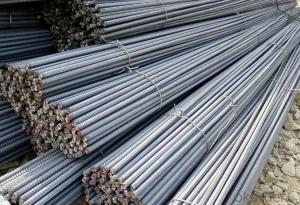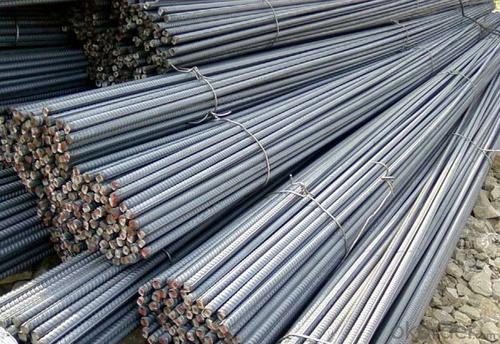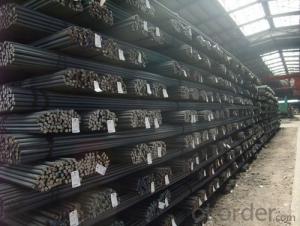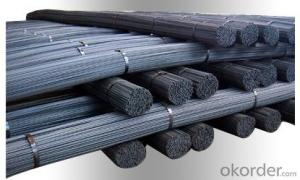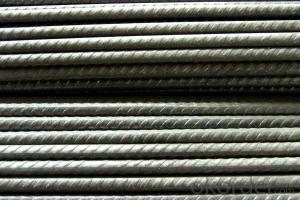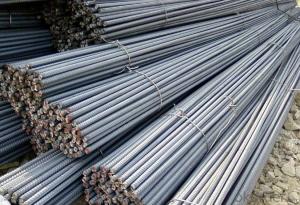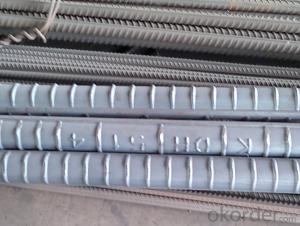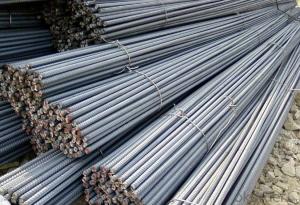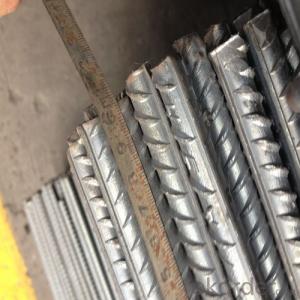Hot rolled deformed bar 6mm-50mm HRB400 ASTM A615
- Loading Port:
- Shanghai
- Payment Terms:
- TT OR LC
- Min Order Qty:
- 25 m.t.
- Supply Capability:
- 20000 m.t./month
OKorder Service Pledge
OKorder Financial Service
You Might Also Like
Deformed Bar Details:
| Minimum Order Quantity: | m.t. | Unit: | m.t. | Loading Port: | |
| Supply Ability: | m.t./month | Payment Terms: | TT OR LC | Package: | wire rod packing |
Product Description:
Product Description:
Specifications of HRB400 Deformed Steel Bar:
Standard | GB | HRB400 | |
Diameter | 6mm,8mm,10mm,12mm,14mm,16mm,18mm,20mm, 22mm,25mm,28mm,32mm,36mm,40mm,50mm | ||
Length | 6M, 9M,12M or as required | ||
Place of origin | Hebei, China mainland | ||
Advantages | exact size, regular package, chemical and mechanical properties are stable. | ||
Type | Hot rolled deformed steel bar | ||
Brand name | DRAGON | ||
Chemical Composition: (Please kindly find our chemistry of our material based on HRB500 as below for your information)
Grade | Technical data of the original chemical composition (%) | ||||||
C | Mn | Si | S | P | V | ||
HRB400 | ≤0.25 | ≤1.60 | ≤0.80 | ≤0.045 | ≤0.045 | 0.04-0.12 | |
Physical capability | |||||||
Yield Strength (N/cm²) | Tensile Strength (N/cm²) | Elongation (%) | |||||
≥400 | ≥570 | ≥14 | |||||
Theoretical weight and section area of each diameter as below for your information:
Diameter(mm) | Section area (mm²) | Mass(kg/m) | Weight of 12m bar(kg) |
6 | 28.27 | 0.222 | 2.664 |
8 | 50.27 | 0.395 | 4.74 |
10 | 78.54 | 0.617 | 7.404 |
12 | 113.1 | 0.888 | 10.656 |
14 | 153.9 | 1.21 | 14.52 |
16 | 201.1 | 1.58 | 18.96 |
18 | 254.5 | 2.00 | 24 |
20 | 314.2 | 2.47 | 29.64 |
22 | 380.1 | 2.98 | 35.76 |
25 | 490.9 | 3.85 | 46.2 |
28 | 615.8 | 4.83 | 57.96 |
32 | 804.2 | 6.31 | 75.72 |
36 | 1018 | 7.99 | 98.88 |
40 | 1257 | 9.87 | 118.44 |
50 | 1964 | 15.42 | 185.04 |
Usage and Applications of HRB400 Deformed Steel Bar:
Deformed bar is widely used in buildings, bridges, roads and other engineering construction. Big to highways, railways, bridges, culverts, tunnels, public facilities such as flood control, dam, small to housing construction, beam, column, wall and the foundation of the plate, deformed bar is an integral structure material. With the development of world economy and the vigorous development of infrastructure construction, real estate, the demand for deformed bar will be larger and larger..
Packaging & Delivery of HRB400 Deformed Steel Bar:
Packaging Detail: products are packed in bundle and then shipped by container or bulk vessel, deformed bar is usually naked strapping delivery, when storing, please pay attention to moisture proof. The performance of rust will produce adverse effect.
Each bundle weight: 2-3MT, or as required
Payment term: TT or L/C
Delivery Detail: within 45 days after received advanced payment or LC.
Label: to be specified by customer, generally, each bundle has 1-2 labels
Trade terms: FOB, CFR, CIF
- Q: What are the different methods of reinforcing concrete structures using steel rebars?
- There are several methods of reinforcing concrete structures using steel rebars. These include placing the rebars in a grid pattern to provide overall strength and support, using stirrups or ties to hold the rebars in place and prevent them from moving, using dowel bars to connect two separate concrete elements, and using anchor bolts or hooks to secure the rebars to the existing structure. Additionally, steel mesh or fiber reinforcement can be used to enhance the overall durability and resilience of the concrete structure.
- Q: Can steel rebars be used in water treatment plant construction?
- Yes, steel rebars can be used in water treatment plant construction. Steel rebars are commonly used in the construction of various structures, including water treatment plants, due to their high strength and durability. They provide reinforcement to concrete structures and ensure their integrity and longevity, making them suitable for use in water treatment plant construction.
- Q: What is the effect of welding defects on the performance of steel rebars?
- The performance of steel rebars can be significantly affected by welding defects, which can weaken their structural integrity and compromise the overall strength and durability of the construction project. Porosity is one of the common welding defects, caused by the presence of gas pockets or voids in the weld. This weakens the weld joint, reducing its load-bearing capacity and making it more prone to cracking or breaking under stress. As a result, the rebars may not be able to resist external forces, such as the weight of the structure or seismic activities, potentially leading to collapse or structural failure. Another welding defect is lack of fusion, which happens when there is insufficient bonding between the base metal and the weld metal. This creates a weak joint that can easily separate or crack under load. Lack of fusion can decrease mechanical strength and compromise structural performance as the rebars may not be able to withstand the expected load or forces. Additionally, the presence of weld spatter or excessive weld reinforcement can also have a negative impact on the performance of steel rebars. Weld spatter refers to undesirable splashes or droplets of molten metal that can stick to the rebar's surface, creating potential weak points. Excessive weld reinforcement adds unnecessary weight to the rebar and creates stress concentrations, further increasing the risk of failure. In conclusion, welding defects can significantly affect the performance of steel rebars by weakening their structural integrity, reducing load-bearing capacity, and increasing the likelihood of cracking or breaking under stress. Therefore, it is crucial to implement proper welding techniques and quality control measures to minimize or eliminate these defects and ensure the safety and reliability of the construction project.
- Q: What are the common problems associated with steel rebars in construction?
- There are several common problems associated with steel rebars in construction. One of the main issues is corrosion. Steel rebars are susceptible to rusting when exposed to moisture and oxygen, especially in humid or coastal environments. This can compromise the integrity of the rebars and weaken the overall structure. Another problem is improper installation. If rebars are not positioned correctly or are not adequately secured, they may not provide the necessary reinforcement and support. This can lead to structural failures and safety hazards. Additionally, the size and spacing of rebars can be a concern. If the rebars are too small or spaced too far apart, they may not effectively distribute loads or resist bending and cracking. On the other hand, if the rebars are too large or placed too close together, it can increase construction costs and make the concrete mix difficult to work with. Another challenge is the potential for poor bonding between the rebar and the concrete. If there is inadequate contact or bonding between the two materials, it can compromise the structural integrity and reduce the load-bearing capacity of the reinforced concrete. Lastly, the quality of the steel rebars themselves can be an issue. Low-quality or substandard rebars may have defects, such as impurities or inconsistencies in their composition, which can weaken the reinforcement and compromise the overall strength of the structure. To mitigate these problems, it is important to use high-quality rebars, follow proper installation techniques, and ensure proper maintenance and protection against corrosion. Regular inspections and testing can also help identify any issues and ensure the longevity and safety of the reinforced concrete structure.
- Q: How do steel rebars affect the durability of concrete?
- The durability of concrete structures is greatly enhanced by steel rebars, as they play a crucial role in various aspects. Firstly, steel rebars increase the tensile strength of concrete. While concrete has impressive compressive strength, it lacks strength when it comes to tension. When external forces or loads are applied, concrete tends to crack and fail under tension. However, by embedding steel rebars within the concrete, the load is effectively distributed throughout the structure, preventing cracking and the propagation of cracks. This reinforcement allows the concrete to withstand greater tensile forces, thus improving its durability. Moreover, steel rebars assist in controlling the shrinkage and cracking of concrete. During the curing process, concrete shrinks due to water evaporation. This shrinkage can lead to the formation of cracks, compromising the structure's integrity. By incorporating steel rebars, the concrete is reinforced, restraining shrinkage and minimizing the occurrence and propagation of cracks. This ensures the durability of the concrete by maintaining its structural integrity. Furthermore, steel rebars have high resistance to corrosion. Concrete is generally alkaline, creating a protective layer on the surface of the steel rebars, preventing rusting or corrosion. This resistance to corrosion is crucial in maintaining the durability of concrete structures, especially in environments where they are exposed to moisture, chemicals, or other corrosive agents. The presence of steel rebars guarantees that the concrete remains structurally sound, preventing any potential weakening or deterioration due to corrosion. In conclusion, steel rebars have a significant impact on the durability of concrete structures. They enhance the tensile strength, control shrinkage and cracking, and provide resistance to corrosion. By reinforcing the concrete, steel rebars ensure that the structure can withstand external forces, maintain its structural integrity, and have a longer lifespan.
- Q: What is the impact of steel rebars on the sustainability of a structure?
- The sustainability of a structure is significantly influenced by steel rebars. To begin with, the usage of steel rebars improves the structure's durability and longevity. Steel is an incredibly durable material that can withstand harsh weather conditions, seismic activities, and heavy loads. Consequently, structures reinforced with steel rebars have a longer lifespan, reducing the need for frequent repairs or replacement. Moreover, steel rebars contribute to the structural integrity of a building. By reinforcing concrete, they help prevent cracks and fractures, ensuring the stability and safety of the structure. This, in turn, diminishes the risk of structural failure, which can have disastrous consequences. Regarding sustainability, the use of steel rebars also promotes resource efficiency. Steel is highly recyclable, with a recycling rate exceeding 90%. Consequently, at the end of a structure's life, the steel rebars can be easily recycled and reused, thereby reducing the demand for new steel production. This not only conserves natural resources but also decreases energy consumption and greenhouse gas emissions associated with steel production. Additionally, the use of steel rebars allows for flexibility in design and construction. They can be easily shaped and bent to meet specific structural requirements, resulting in more efficient use of materials and decreased waste. This flexibility also enables the construction of intricate and innovative structures, fostering architectural diversity and creativity. Lastly, steel rebars offer fire resistance, which is crucial for the safety of a structure and its occupants. Steel does not burn or contribute to the spread of fire, providing a higher level of fire resistance compared to other materials. This feature enhances the overall sustainability of a structure by reducing the risk of fire-related damage and loss. In conclusion, steel rebars positively impact the sustainability of a structure. They enhance durability, contribute to structural integrity, promote resource efficiency through recycling, enable flexibility in design and construction, and provide fire resistance. These factors collectively enhance the lifespan, safety, and environmental performance of a structure, making steel rebars a crucial component for sustainable construction.
- Q: How do steel rebars prevent concrete structures from cracking under load?
- Steel rebars prevent concrete structures from cracking under load by providing reinforcement and increasing the tensile strength of the concrete. When the concrete is subjected to tensile forces, such as those caused by the weight or movement of the structure, it is prone to cracking. However, the inclusion of steel rebars within the concrete helps to distribute these tensile forces throughout the structure, making it more resistant to cracking. The steel rebars act as a framework, absorbing and dispersing the tension, thereby enhancing the overall structural integrity and preventing cracks from forming.
- Q: Can steel rebars be used in offshore oil rig construction?
- Yes, steel rebars can be used in offshore oil rig construction. They are commonly used to reinforce concrete structures and provide strength, durability, and stability to the offshore platforms. The rebars are designed to withstand the harsh marine environment and the extreme conditions present in offshore drilling operations.
- Q: Can steel rebars be used in both residential and commercial construction?
- Indeed, steel rebars find extensive utility in both residential and commercial construction endeavors. These rebars frequently serve as reinforcement within concrete structures, endowing them with heightened fortitude and longevity. They prove apt for an array of applications, encompassing foundations, walls, columns, beams, and slabs - all of which are integral components within both residential and commercial construction projects. By employing steel rebars, one guarantees that the concrete structures can withstand the burdens and pressures they encounter, rendering them suitable for diverse construction ventures, regardless of their magnitude or objective.
- Q: Are there any alternative materials to steel rebars?
- Yes, there are alternative materials to steel rebars. Some examples include fiberglass, carbon fiber, and basalt rebar. These materials offer advantages such as higher strength-to-weight ratios, corrosion resistance, and better durability in certain environments. However, the selection of alternative materials depends on specific project requirements and cost considerations.
Send your message to us
Hot rolled deformed bar 6mm-50mm HRB400 ASTM A615
- Loading Port:
- Shanghai
- Payment Terms:
- TT OR LC
- Min Order Qty:
- 25 m.t.
- Supply Capability:
- 20000 m.t./month
OKorder Service Pledge
OKorder Financial Service
Similar products
Hot products
Hot Searches
Related keywords
